Møre og Romsdal
county of Norway
Møre og Romsdal is a county in Western Norway. It is the most northerly of the famous west coast fjord regions and its northern location possibly cuts visitors - but it yields to none of the others in its scenery. It is an area of iconic fjords but also of alpine mountains rising directly from the ocean, countless waterfalls, myriad of islands, rugged coast and great valleys. There are also interesting man-made sights such as the unusual city of Ålesund and the Trollstigen mountain road.
Regions
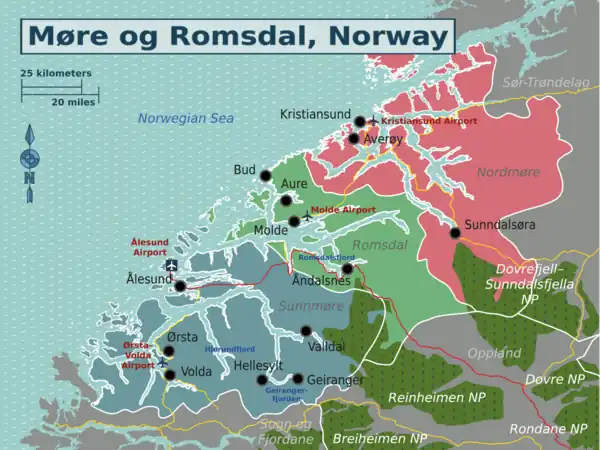
| Nordmøre The northern coastal region around Kristiansund and the inner area around Sunndal Valley. |
| Romsdal The area around the great Molde fjord and the monumental Romsdal Valley. |
| Sunnmøre The southern region around Ålesund and the iconic Geirangerfjord and lovely Hjørundfjord. |

Towns
There are no large cities in Møre og Romsdal, but there are a few towns around. These are mainly:
- 🌍 Kristiansund — Compact archipelago town, known for being the clip fish capital of Norway.
- 🌍 Molde — County administrative centre, known as "The town of roses". Hosts Norway's largest jazz festival and a great panorama of the mountains in the south.
- 🌍 Ålesund — The largest town in Møre og Romsdal which is characterized by its narrow Art Nouveau dominated centre.
- 🌍 Åndalsnes — Small town and transportation hub, marks the end of Møre og Romsdal's only railway, Raumabanen, and is surrounded by the Romsdals alps.
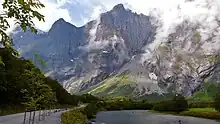
Other destinations
- 🌍 Aure — a typical coastal municipality, with many beautiful small islands
- 🌍 Averøy — many people describe Averøy as a "miniature of Norway" as all the landscape typical to Norway is represented here
- 🌍 Geiranger — the steep-sided fjord with its waterfalls, including the Bridal Veil and the Suitor. Geiranger-Hellesylt ferry, Hurtigruten (summer) and cruise ships travel the fjord. In UNESCO area with Hellesylt nextdoor at the other end of Geirangerfjord
- 🌍 Hjørundfjord — surrounded by towering, snow-clad alpine summits rising directly from deep fjord. See it by ferry and/or car, or cruise ship.
- 🌍 Sunndal — great valley stretching from the fjord to uplands at Oppdal, surrounded by alpine mountains and countless waterfalls
- 🌍 Valldal — fertile valley and great fjord on the scenic Road 63
- 🌍 Road 63 — a 100-km regional route in Møre og Romsdal between Åndalsnes and Skjåk/Stryn via Valldal and Geiranger; the route runs through some of Norway's top sights, including the Trollstigen mountain pass and an excellent panorama of the famous Geirangerfjord.
Understand
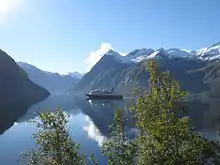
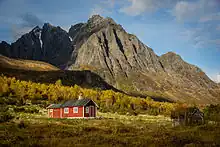
- See also: Fjords of Norway
Møre og Romsdal county includes deep fjords, towering alpine mountains, gentle valleys, countless green islands, wide forests, the wild Atlantic coast, impressive mountain roads, numerous lakes, barren mountain plateaus, charming mountain farms, and the highest waterfalls in Norway. This region is rich in natural resources such as fisheries, natural gas and hydro electric power. While the area is famous for its iconic fjords and tall waterfalls in the interior, the county is in fact largely facing the ocean. Two of three main towns, Kristiansund and Ålesund, both sits on islands. In 2009, Kristiansund was finally connected to the main land by complex tunnel and bridge systems. Important industry as well as two of four airports are on islands. The interior is sparsely populated, while the most population is concentrated on islands and outer areas.
The highest mountains and waterfalls are in the district around Hjørundfjord, Geiranger, Valldal, Tafjord, Åndalsnes, Eikesdalen valley and Sunndal valley. Around Hjørundfjord and Åndalsnes are the some the most alpine areas in Norway, known as Sunnmøre alps and Romsdal alps respectively. The rivers of Sunndal, Geiranger and Romsdal flow west/northwest from the watershed. In Geiranger the river flows few kilometers to the fjord while the corresponding rivers in East Norway flow gently 600 km to the Oslo fjord. This means that western rivers are much more powerful and has for thousands of years dug deep into the bedrock creating gorges and waterfalls, this process has also shifted the watershed east/south such that what was once tributaries to the eastern rivers became tributaries to western rivers. While the water in these tributaries end up in a western fjord, their valley still point south/east, this phenomenon is known as "reverse" or "barb valley". Such barb valleys can be seen in the upper parts of Romsdalen and Sunndal valleys. The transition from the mellow landscape of the eastern interior to the "wild west" in Møre og Romsdal is particularly memorable from a drive from east to west in Norway. The change from East to West occurs over a few kilometers near the county line at Geiranger, at Verma in Romsdalen, near Finnset in Eikesdalen and at Gjøra in Sunndalen.
In the inner areas the steep mountains and deep valles of the west turns into gently sloping valleys and high plateaus of the east. The Tafjord mountains overlaps with the Reinheimen uplands that stretches far into Oppland. The high mountains of Romsdalen, Eikesdalen and Sunndalen is part of the wider Dovrefjell area part of which is protected as a national park. Trollheimen mountains of Trøndelag are shared with Sunndal and Surnadal.
The coast line is very because of the long fjords and countless islands. Along fjords there are few beaches and mostly steep hills or cliffs directly into the water. There beaches, including some sandy, on the islands. Fjords are mostly very deep and during summer there is a constant inflow of meltwater that cools the surface. Fjords heat slightly during summer.
Along the coast and to the north (in the Nordmøre area closer to Trondheim), the mountains are lower, less steep and the forests wide and deep. Due to the deep fjords and numerous islands all parts of this region has easy access to the Atlantic and transport depends on ferries. While Geiranger has for 100 years been a popular destination, there is a number of great fjords in all parts of the county.
This area, partly together with Nordfjord, is often referred to as the "northwest" - that is the northern part of Western Norway (Stavanger and surrounding region in contrast is informally called the southwest).
Ålesund is the youngest town in the area and grew rapidly from late 1800s as the centre of commerce. Ålesund is one of Norway's main fisheries ports. Molde is the administrative centre, while Kritiansund developed early as a trading post and capital of "dried cod fish". Ålesund is still the most interesting as it was rebuilt in an idiosyncratic style after the devastating 1904-fire. Molde and Kristiansund (along with Åndalsnes) were destroyed by bombs and fire during the German invasion in 1940, then rebuilt in a less interesting post-war style.
Climate
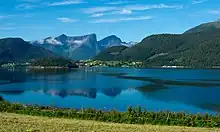
Møre og Romsdal weather is dominated by the North Atlantic. On the islands and close to the ocean it's never really hot in summer and rarely cold in winter. Fog tends to emerge on warm summer days. At the eastern end of fjords and in the long valleys, summers are warmer and gentler. Strawberries, apples and cherries are grown commercially in the warm valleys and at the southern slopes along fjords. In places like Valldal and Geiranger there is typically snow cover from December to April, frequently 50-100 centimeters heavy snow, occasionally more than 100 centimeters in the valley. On mountain passes like Trollstigen and Geiranger road there can be several meters of snow during winter. At sea level along fjords and on islands like Kristiansund and Ålesund there is usually very little snow.
Note that temperature is closely related to altitude. In the mountains, the temperature can be close to 0 °C even in summer. Snow occasionally falls on the highest summits even during summer.
Talk
As in the rest of Norway, virtually everybody speaks or understands English. In tourist hot spots, like Geiranger, French and German are also common among service personnel. Due to some immigration from Poland, the Netherlands etc., don't be surprised to meet service workers that manage other languages as well.
The language in Møre og Romsdal is Norwegian, with dialects that are distinctly different from Oslo and Bergen dialects. In the northern area (Nordmøre), the dialect is similar to Trondheim dialect.
Get in
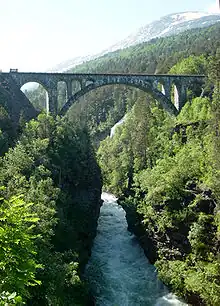
By plane
There are four airports in the county, at Ålesund, Molde, Ørsta/Volda and Kristiansund. Ålesund has the best connections and can be reached from Oslo, Bergen, Trondheim and some international cities like London.
- Ålesund Airport, Vigra
- Molde Airport is few kilometer just east of the centre of Molde.
- 🌍 Ørsta—Volda Airport. (HOV)
- Kristiansund Airport
By rail
The Rauma railway terminates at Åndalsnes and runs parallel to road E136, and are connected to Oslo and Trondheim via Dombås junction. This is also a very scenic piece of railway.
By boat
A large number of cruise ships (mostly departing from Denmark, Britain or the Continent) visit towns and fjords every summer. Hurtigruten has daily departures from Bergen and Trondheim towards the coastal ports of Kristiansund, Molde and Ålesund.
By bus
Both Nettbuss and NOR-WAY Bussekspress have bus services that can bring you in to the area.
By car
From the inland Road E136 connects the region to road E6 (Norway's main north-south road) at Dombås. About seven hours from Oslo to Åndalsnes. E136 is an all-year road and the main access by car to the county.
In summer, the region can also be reached via the famous Geiranger road. Road 15 from Otta (on E6) connects to Road 63 on the mountain pass above Geiranger.
From the south On the west coast, the main entrance to Møre og Romsdal is the E39 from Bergen to Volda, Ålesund and Molde. Tourists should consider the more scenic Road 60 (connecting to E39 at Byrkjelo) across a small mountain pass, further along fjords and through Olden and Stryn to Hellesylt.
From the north The E39 is also the main entrance from Middle Norway (Trøndelag) and Trondheim. Tourists could however consider the more scenic road 70 through Sunndal valley connecting to E6 at Oppdal.
Get around

By rail
The only railway in this district ends at Åndalsnes and covers only the stretch from Dombås via Bjorli down Romsdalen valley.
By bus
Frequent buses connect the towns, whereas in remote areas there may be only one or two buses daily. Search using rutebok.no.
By road
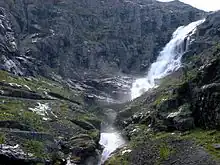

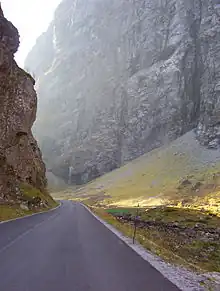
- See also: Driving in Norway
Your own car or motorcycle is the best way to get around and travel at your own speed and reaching and stop at the most scenic places.
Hitchhiking is a cheap way to travel the tourist routes. Many drivers won't let hitchhikers on, so don't expect immediate response.
Cycling is a nice way to move around the varied landscape, steep hills and numerous tunnels are challenging. Read maps carefully to avoid long tunnels on main roads. In some tunnels, bicycles are not allowed.
- Iconic Road 63 has only one short tunnel (which can be circumvented).
- Road 136 Dombås-Bjorli-Åndalsnes has no tunnels, but heavy traffic at rush.
- Road 136 Åndalsnes-Sjøholt has several long tunnels and often heavy traffic
- Road 64 Molde-Atlantic road-Averøya has no tunnels.
- Road 60 Ålesund-Stranda has no tunnels
- Road 655 Hellesylt-Sæbø-Ørsta has no tunnels
- Tunnels to islands are deep and steep (notably Ørsta-Ulsteinvik, Kristiansund road 64, and tunnels to Ålesund airport), not for bicycles.
- Road 650 Sjøholt-Valldal has 6 tunnels (alternative is road 60 via Stranda)
- Road 60 Stranda-Hellesylt has 2 long tunnels, not recommended
- Road 60 Hellesylt-Stryn has 1 tunnel that may be circumvented along abandoned road
- Winter
The Møre og Romsdal area stretches from the shores of the mild Atlantic where there are only brief periods of frost and snow, to the high mountains and interior with heavy snowfalls and periods of deep frost. Trollstigen and Geiranger mountain passes on Road 63 are always closed during winter (usually November to mid May). Ice and snow is common on all roads during the winter months December-March, in the interior and uplands from late October to mid April. Some roads are occasionally closed by avalanche. Travel in winter should always allow generous time for the unforeseen.
By boat
Ferries like the Geiranger-Hellesylt ferry or the longer Valldal-Geiranger ferry offer opportunities to rest for the bicycle traveler.
Because of the many islands and deep fjords, Møre og Romsdal has a large number of relatively short (10-20 min) ferry crossings. Car ferries are an integral part of the road network and trips across this county always involves ferries, but these ferries are generally not a separate means of transport. Car ferries on the main roads are rather frequent (typically every half hour), extremely reliable and operate with reserve capacity. Except for the popular Geiranger-Hellesylt and Valldal-Geiranger ferries, tourists need not worry about time tables and reservations. Tourists are however recommended to calculate plenty of time for trips involving car ferries. Buses, ambulances and livestock transport have priority. On the longer crossings, ferries have cafeteria selling coffee, beverages, sandwiches and some hot food. Menu also include the typical thick pancake ("svele") served with brown cheese, butter or marmalade.
There are in addition a few express boats (passengers only).
For additional information regarding public transportation in Møre og Romsdal, contact the public transport information Trafikanten Møre og Romsdal or on phone number +47 177.
See
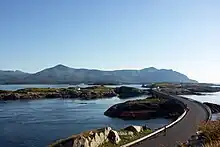

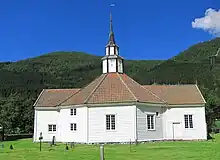
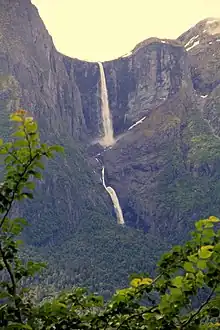
The most important sights in Møre og Romsdal is the nature and landscape itself, although the old centre of Ålesund and some charming villages and mountain farms are worth a visit. A number of interesting and impressive road constructions are perhaps the most important man-made attractions in this region. Trollstigen, Atlanterhavsveien and the Geiranger road are some of the great road constructions. There is also a number of great constructions related to hydro electric power production notably in Tafjord and Sunndal. The best way to see and experience this area is by driving your own car, taking a bus tour or by taking a cruise on the fjords and see something of the below.
Cultural
- Cities. Molde and Kristiansund were both destroyed during the second world war. Except for the church, Molde is largely not interesting in terms of architecture. After the war Kristiansund became a well-planned and functional but not particularly interesting city, except for the unusual church and a handful pretty old wooden buildings. Ålesund is by far the most interesting city in the area, also rebuilt after a complete destruction, but in the bold local variant of the Jugend-style (art nouveau).
- Stave churches. Møre og Romsdal is home to three of Norway's 30 remaining stave churches: at Rødven (road 64 between Molde and Åndalsnes), Kvernes (detour from road 64 at Averøy), and on Grip island near Kristiansund (with an ancient winged altarpiece). The Møre og Romsdal stave churches are less conspicuous than those found in Sogn, Valdres and Hallingdal, but are nonetheless witnesses to ancient construction technique, decorative style and religious life.
- Other churches. Møre og Romsdal also has many octagonal wooden churches mostly built about 200 years ago. The elongated octagonal shape is characteristic for the western areas, including the shapely churches in Aukra, Kleive, Norddal, Stordal, Stranda, Tresfjord and Ulsteinvik. The plain white exterior of the churches in Stordal and Tresfjord conceals a richly decorated interior. In the more eastern areas the regular octagon dominates, giving the churches at Åndalsnes, Ålvundeid and Sunndal the shape of a circus tent. Most old churches are wooden, except Tingvoll, Borgund (Ålesund) and Giske churches. The elegant Molde cathedral is a modern building partly with a traditional style, while Kirklandet church in Kristiansund was the first truly modern church building with complete departure from traditional style.
- 🌍 Tingvoll Church (Tingvoll kyrkje), Tingvoll village. This imposing 12th-century masonry church is unusual for a small village. Tingvoll church was presumably the main church ("cathedral") for Nordmøre in catholic times. Walls are some 2 m thick with hidden stairs and corridors. The only church in Norway with such an elaborate system. An elegant runic inscription above the altar sendes a message through the centuries from Gunnar, the church's Builder: "Remember my soul in Your holy prayers, I was Gunnar and made this house. Live well"
- 🌍 Tresfjord Church (Tresfjord kyrkje), Sylte in Tresfjord. Small elegant octagonal wooden church typical for this area. Built in 1828 but includes elements from several previous churches notably an "antemensale" or painted altar front from around 1300. This is the only one not kept in a museum and the assumed to be one of the oldest oil paintings in Europe. It was discovered by conservation experts in 1920s. Norway has in total some 30 surviving painted altar fronts from that period, only Catalonia with some 80 altar fronts from the previous centuries has something similar. (updated Jun 2020)
- 🌍 Rose Church (Old Stordal Church / Rosekyrkja) (road 650 from Sjøholt or Valldal, close to the road). 11 to 16 (summer only). The white old church in Stordal valley is a good example of the idiosyncratic wooden octagonal churches typical for the area (similar churches in Norddal, Tresfjord, Leikong, Geiranger, Ulsteinvik, Stranda, Innvik and Tresfjord). It is known as the Rose church because of the rose paintings covering its interior. Paintings are in a naïve but striking style. Some are merely decorative, others depict characters or events from the bible. It was built in 1789 in place of an ancient stave church at the site, materials were partly reused, so the oldest pieces may date back hundreds of years. A traditional residential house typical for the area is displayed next door. It is owned by the Society for the Preservation of Ancient Norwegian Monuments. 35 kr.
- 🌍 Atlantic Ocean Road (Atlanterhavsveien) is an exciting and elegant road engineering at the edge of the Atlantic. It is an 8-km-long stretch of road connecting Averøy to the mainland via a stretch of several islets connected by 8 bridges. By car, it is one of two possible routes between Kristiansund and Molde.
- Downtown Ålesund has many art nouveau (Jugendstil) buildings built after the devastating 1904 fire. Ålesund is also the regional centre with shopping malls and airport.
- Dalsnibba and Geiranger road has countless hairpin bends. Detour on tollroad to Dalsnibba summita 1500 m (4920 ft) mountain summit. Faboulus view over the fjord and the mountain behind. Detour from road 63 (Geiranger mountain pass) direction Skjåk and Stryn (summer only). The northern access to Geiranger village via the steep Eagle's road with several hair pin bends. Iconic panorama of Geirangefjord (all year). Both roads part of road 63 Åndalsnes-Valldal-Geiranger-Skjåk/Stryn.
- Zacharias dam, 20 km from Valldal, is a 95-m-high concrete dam in a narrow river gorge. The main reservoir for the Tafjord hydro power complex. In nearby Tafjord village the power station built in the 1920s, which is now museum.
- 🌍 Skodje bridges (Skodjebruene), Skodje (Road 661, small detour from E136 to Ålesund). These elegant bridges are the longest masonry arch bridges constructed in Norway. Notably longer than Kylling bridge on Rauma railway. Protected as cultural heritage. Now open only to pedestrians, new bridge for cars built parallel. (updated Mar 2015)
Natural
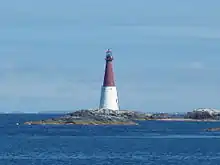
- Grip is a former fishing community on an island in the Atlantic 15 km from Kristiansund. Grip has a stave church and a tall lighthouse.
- 🌍 The Mardal Waterfall (Mardalsfossen) (reachable by car, at the south end of the Eikesdal lake). Waterfall at a total height of 705 m containing two drops where the longest, with its almost 300 m of free fall, is the 4th tallest in the world. Approach by car along impressive Eikesdal lake. free.
- 🌍 Romsdal valley (Rauma railway or road E136). The impressive Romsdal valley is a 1500-m-deep canyon in the bedrock, stretching some 40 km from Bjorli to Åndalsnes. The wonderful Rauma river alternates between wild waterfalls and tranquil salmon pools. The entire Romsdalen valley stretching from Åndalsnes to Bjorli on Road E136. Waterfalls at Monge, Verma and Sletta. Mountains Trolltindane including Trollveggen, Romsdalshorn, and Mongegjura. Trollveggen is a vertical rock face rising 1000 m from the floor of the majestic Romsdal valley. Climbers' challenge and hotspot. Visible from main road E136 (parking) and railway.
- 🌍 Ona Lighthouse (Ona fyr).
- 🌍 Åmotan gorge & waterfalls (Åmotan), Sunndal valley road 314 (Road 70 to Gjøra, then 314). Åmotan is the confluence of several rivers in a gorge on the border of Dovre-Sunndal national park. The spectacle can be seen by car near the main road (70) through Sunndal valley. Steep mountain cliff, moraines and terraces creates a fan-shaped river system where five rivers meet. Three rivers form magnificent waterfalls. The area is facilitated with well-marked trails and accompanying maps. (updated Mar 2015)
- Trollstigen mountain pass on Road 63 between Åndalsnes and Valldal, is a mountain road climbing the pass between Isterdalen valley in the north and Valldal valley in the south. This road is one of the most visited destinations in Norway (summer only).
- 🌍 Trollkyrkja (Troll's Church), Fræna north of Molde (road 64). Three limestone/marble caves with underground rivers and waterfalls. 400 meter elevation gain to entrance. The area is rich in marble and limestone. Free. (updated Dec 2015)
Itineraries
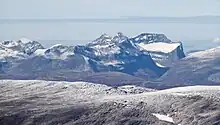

Alpine Highlights - by car From Otta on E6 road 15 passed Grotli, change to road 63, make a detour to Dalsnibba (at Djupvasshytta), continue down the famous Geiranger road (don't stop in Geiranger village), continue up Eagle's Highway (short stop for photos near the top) on road 63. Take the ferry from Eidsdal to Linge (10 minutes), at Linge turn left onto road 650 for a 10-km detour to Liabygda, enjoy the panorama, and return to Valldal village on road 63. Return to Valldal village and continue up Valldal valley on road 63 towards Trollstigen, short stop at Gudbrandsjuvet to look at the gorge, continue to the mountain pass and drive down Trollstigen after stop "on the edge". Continue towards Verma and look at the waterfalls there. Connect to E6 at Dombås.
Do
- Fishing. In addition to a lot of possibilities for ocean fishing, both Rauma and Surna are excellent rivers for fishing. Note: Rivers are private and permission must be purchased.
- Molde International Jazz Festival. Norways largest jazz festival
- Nordic Light International Festival of Photography. Photography festival held April/May annually in Kristiansund.
- The Rauma Railroad (Raumabanen). Romsdal railway from Dombås to Åndalsnes - one of Norway's most scenic stretches of rail. The railway line itself is an engineering accomplishment. It includes two hairpin bends, one inside a tunnel and one crossing the river.
- Raumarock. Popular Rock Festival held in Åndalsnes in August every year.
- Skiing (alpine). There are several winter sports resorts in the area. Notably the snow rich Stranda skiing centre. This is one of the few ski resorts overlooking a fjord. Deep snow and many off-piste options with a fjord view. Stranda in 2018 was ranked as the 6th best ski resort in Norway. The Stranda gondola lift also operates in summer, great panorama from summit. There are also many areas where off-pist skiing also is possible and very common - caution: avalanches are common on steep, snow-rich off-piste slopes.
- Trekking and hiking. The area offers countless opportunities for summer hiking, from gentle valleys and islands to the most demanding rock-face climbing. Along fjords and island, short rewarding day hikes are possible. More inland (around Tafjord, Romsdal, Sunndal, Eikesdal) there are many trekking routes along marked trails. Caution: Do not walk near or on glaciers without a guide and proper equipment.
- Whale safariing. It's possible to do killer whale safaris in the coastal regions some parts of the winter. Caution: Do not go out in a small boat on your own. .
Eat
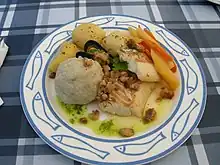
The county has long traditions in fishing and is famous for its bacalao. Kristiansund in particular were pioneers in the export of dried-salted cod, klippfisk, and export to Portugal and Spain also resulted in the import of dishes such as bacalo (cod in one-pot with tomato, onion and potatoes). Another "typical" dish worth mentioning is "Raspeball" (potatoe dumpling). A particular variant in this area is potato-fish dumpling, known as mixed-dumplings (blandeball) or fish-dumplings (fiskeboller). Also try the typical thick pancake ("svele") served on ferries.
Drink
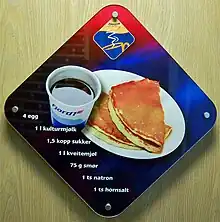
Most towns have a few or more nightclubs and pubs, and decent nightlife in the weekends.
Slogen beer, brewed in Liabygda at Sunnmøre is supposed to be a superb contest-winning local beer brand.
Sleep
Stay safe
Norway has in general a low crime rate. Møre og Romsdal does not have any big cities where crime is relatively more frequent. Violent crimes are very rare. Petty thefts and vandalism are the most common form of crime. Most communities in Møre og Romsdal are small, peaceful villages where everybody knows each other, and tourists do not need to worry about their safety in public places. Tourists should however watch their belongings in crowded tourist spots like Geiranger and in the busy shopping areas of Ålesund.
People generally drive carefully on mountain roads and few car accidents happen even if many tourists feel unsafe. Drivers tend to use their brakes too much, causing the brake fluid to boil. Use a low gear and let the engine control the speed downhill.
Møre og Romsdal has large numbers of red deer (hart, "hjort") that can suddenly jump into the road at dusk and dawn (particularly where road is passing through dense forest). The red deer is much smaller than the moose (elk) found in Eastern Norway, but can still create a dangerous situation and cause serious damage to your car. Note the special warning sign. Call the police at 02800 (or emergency number 112) if you wound an animal.
Do not walk near or on glaciers without a tour guide and proper equipment. Do not underestimate the risk on slippery slopes (particularly near waterfalls).
Do not underestimate the power of waves along the Atlantic. Always wear a life west when in a small open boat. Keep well away from the sea in stormy weather - wave height may suddenly cause surprises.
Go next
| Routes through Møre og Romsdal |
| Ålesund ← Åndalsnes ← | W |
→ Romsdalen → Dombås |
| Bergen ← Førde ← | S |
→ Orkanger → Trondheim |
| Kristiansund ← | W |
→ Sunndal → Oppdal |